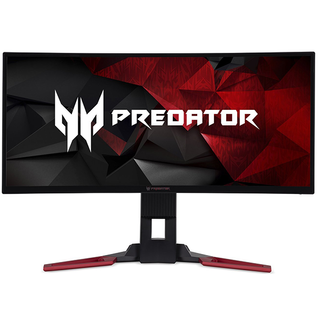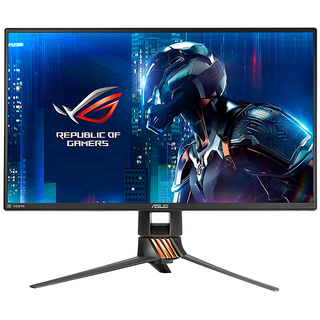Acer Predator XB252Q 240Hz Monitor Review
Why you can trust Tom's Hardware
Brightness & Contrast
To read about our monitor tests in depth, please check out Display Testing Explained: How We Test Monitors and TVs.Brightness and Contrast testing is covered on page two.
Uncalibrated – Maximum Backlight Level
There are plenty of high-speed monitors available today but only the Asus PG258Q truly performs on the XB252Q’s level when it comes to gaming. To round out the group, we have AOC’s AG271QG, Acer’s Z301C, ViewSonic’s XG2703-GS, and the sole screen without G-Sync, Monoprice’s MP27 Zero-G. All are capable of at least 144Hz.



The latest G-Sync monitors have truly improved their ULMB implementation by offering high light output. You’ll need that headroom to compensate for the unavoidable brightness reduction caused by a backlight strobe. The XB252Q pumps out 441.7892cd/m2, which is well-above its 400cd/m2 spec. That contributes to a higher black level, but resulting contrast is reasonable at just over 900:1. If dynamic range is your top priority, you’ll need to choose an AMVA panel like the Z301C, which has almost triple the contrast of the next best display.
Uncalibrated – Minimum Backlight Level



106.7008cd/m2 is a bit bright for gaming in the dark, but you could turn on a dim overhead light or use the Blue Light feature to prevent fatigue during long play sessions. That high minimum output contributes to a last place finish in the black level test, but contrast remains consistent at 894.2:1. It seems the IPS panels in the group have a slight advantage in image depth, but AMVA still ranks far above all.
After Calibration to 200cd/m2



ULMB at maximum pulse width only costs about 20% output, which is a good thing. Since the brightness slider is independently adjustable, you can run it up to its maximum for around 320cd/m2, which exceeds many other monitors in their normal modes. The cool part is black levels are lower, which takes contrast to just under 900:1, a 4% advantage. We haven’t seen that before, and it signals a trend of improvement in the technology. ULMB is no longer simply something to add to the feature list. It has become a usable way to reduce motion blur now that it doesn’t require so much compromise in brightness and contrast performance.
ANSI Contrast Ratio

The XB252Q’s ANSI contrast is only a tad lower than its sequential number, which indicates good panel quality. The grid polarizer is fitted precisely, preventing unwanted backlight bleed and hotspotting. Our uniformity tests on page five show that our sample is a solid performer. While this monitor doesn’t have fantastic contrast, it is consistent and reliable.
MORE: Best Gaming Monitors
MORE: Best Professional Monitors
MORE: How We Test Monitors
MORE: How To Choose A Monitor
MORE: All Monitor Content
Current page: Brightness & Contrast
Prev Page OSD Setup & Calibration Next Page Grayscale, Gamma & ColorStay on the Cutting Edge
Join the experts who read Tom's Hardware for the inside track on enthusiast PC tech news — and have for over 25 years. We'll send breaking news and in-depth reviews of CPUs, GPUs, AI, maker hardware and more straight to your inbox.

Christian Eberle is a Contributing Editor for Tom's Hardware US. He's a veteran reviewer of A/V equipment, specializing in monitors. Christian began his obsession with tech when he built his first PC in 1991, a 286 running DOS 3.0 at a blazing 12MHz. In 2006, he undertook training from the Imaging Science Foundation in video calibration and testing and thus started a passion for precise imaging that persists to this day. He is also a professional musician with a degree from the New England Conservatory as a classical bassoonist which he used to good effect as a performer with the West Point Army Band from 1987 to 2013. He enjoys watching movies and listening to high-end audio in his custom-built home theater and can be seen riding trails near his home on a race-ready ICE VTX recumbent trike. Christian enjoys the endless summer in Florida where he lives with his wife and Chihuahua and plays with orchestras around the state.
-
Lucky_SLS These 240Hz r for the Hardcore Henry of e-sports gamers,Reply
Bring out the HDR and FreeSync 2 beauties !!! -
dstarr3 The last time I had a TN panel was 15 years ago. I should give them another shot, they probably look a lot better today than they did the last time I had one.Reply -
AgentLozen I'm happy to see that engineers keep pushing the limits of panel technologies. It's a shame that this monitor couldn't have ran at a higher resolution or used a better display technology. Subjectively, can you see the difference between 144Hz and 240Hz?Reply
DSTARR3 said:The last time I had a TN panel was 15 years ago. I should give them another shot, they probably look a lot better today than they did the last time I had one.
I'm using a Dell TN at home. After a little calibration, I think it looks great. Sometimes I notice the shoddy viewing angles and I sometimes wonder if it would look a little nicer with 8-bit color, but I'm satisfied otherwise. If you're in the market for a gaming monitor and you don't have bionic eyes that are sensitive to minor color inaccuracy, I'm sure this monitor would be great for you. -
joz Maybe I'm showing my age...Reply
But when did Acer become a premium product supplier? They used to sit right above "EMachines" when it came to jokes (and spec sheets) about their products performance and quality.
That being said, I've been perfectly happy with my XB27. -
dstarr3 Reply20172847 said:I'm happy to see that engineers keep pushing the limits of panel technologies. It's a shame that this monitor couldn't have ran at a higher resolution or used a better display technology. Subjectively, can you see the difference between 144Hz and 240Hz?
DSTARR3 said:The last time I had a TN panel was 15 years ago. I should give them another shot, they probably look a lot better today than they did the last time I had one.
I'm using a Dell TN at home. After a little calibration, I think it looks great. Sometimes I notice the shoddy viewing angles and I sometimes wonder if it would look a little nicer with 8-bit color, but I'm satisfied otherwise. If you're in the market for a gaming monitor and you don't have bionic eyes that are sensitive to minor color inaccuracy, I'm sure this monitor would be great for you.
I actually do have "bionic eyes," lol. I do a lot of photo editing that relies on color-accurate, calibrated displays, and I can pretty reliably detect inaccuracies, which is why I ditched TN panels 15 years ago. But that being said, I don't really need critical accuracy when playing games. I think I'd be alright with a super-high refresh rate at the expense of super-accurate color in games. So long as it looks, like, not obviously way off, I'm sure I'd be fine with it. The viewing angles might be problematic, though. -
ubercake How can Acer use the same panel as Asus and provide a monitor with the same specs, but in reality so much lower contrast? $70 difference.Reply -
AgentLozen ReplyDSTARR3 said:I think I'd be alright with a super-high refresh rate at the expense of super-accurate color in games.
That's what I'm trying to describe. There's never been a time when I was like, "Does Mercy have brown hair or blonde hair?" The picture is pretty good especially after a little calibration. I'm speaking from the experience of my Dell TN.
-
dstarr3 Reply20173399 said:How can Acer use the same panel as Asus and provide a monitor with the same specs, but in reality so much lower contrast? $70 difference.
If I had to guess, binning. The panels roll off the line, some are better than others, Asus pays the premium for the best ones, Acer takes the rest.


